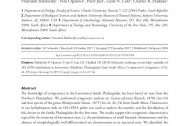Obsah
The knowledge of cytogenetics in the harvestmen family Phalangiidae has been based on taxa from the Northern Hemisphere. We performed cytogenetic analysis on Guruia africana (Karsch, 1878) (2n=24) and four species of the genus Rhampsinitus Simon, 1879 (2n=24, 26, 34) from South Africa. Fluorescence in situ hybridization with an 18S rDNA probe was used to analyze the number and the distribution of this cluster in the family Phalangiidae for the first time. The results support the cytogenetic characteristics typical for the majority of harvestmen taxa, i.e. the predominance of small biarmed chromosomes and the absence of morphologically well-differentiated sex chromosomes as an ancestral state. We identified the number of 18S rDNA sites ranging from two in R. qachasneki Kauri, 1962 to seven in one population of R. leighi Pocock, 1903. Moreover, we found differences in the number and localization of 18S rDNA sites in R. leighi between populations from two localities and between sexes of R. capensis (Loman, 1898). The heterozygous states of the 18S rDNA sites in these species may indicate the presence of XX/XY and ZZ/ZW sex chromosomes, and the possible existence of these systems in harvestmen is discussed. The variability of the 18S rDNA sites indicates intensive chromosomal changes during the differentiation of the karyotypes, which is in contrast to the usual uniformity in chromosomal morphology known from harvestmen so far.



